Key Audit Matters: ASA 701 Analysis of Qantas Airways Financial Report
VerifiedAdded on 2022/09/08
|11
|3551
|24
Report
AI Summary
This report delves into the application of Auditing Standard ASA 701, specifically examining Key Audit Matters (KAM) within the context of Qantas Airways' financial report for the year ending June 30, 2018. The report begins with an executive summary outlining the objective, which is to analyze how Qantas's auditors, KPMG, have addressed KAM as per ASA 701. The introduction provides the rationale behind ASA 701, emphasizing its role in enhancing transparency and providing additional insights to financial statement users. The report then details the process of determining KAM, including the identification of noteworthy matters and the auditor's judgment. It provides background on Qantas and then details the audit report, including the specific KAM highlighted by KPMG: recognition of passenger revenue, revenue recognition for frequent flyer programs, and accounting for derivative financial instruments. The report explores how these matters were addressed by the auditors, concluding with a summary of the findings and their implications. The report highlights the complexity of revenue recognition due to various ticket conditions, the judgments involved in estimating deferred revenue for frequent flyer programs, and the intricacies of accounting for derivative financial instruments. The analysis provides insights into the auditor's approach to these matters, including the use of IT specialists and actuarial expertise.
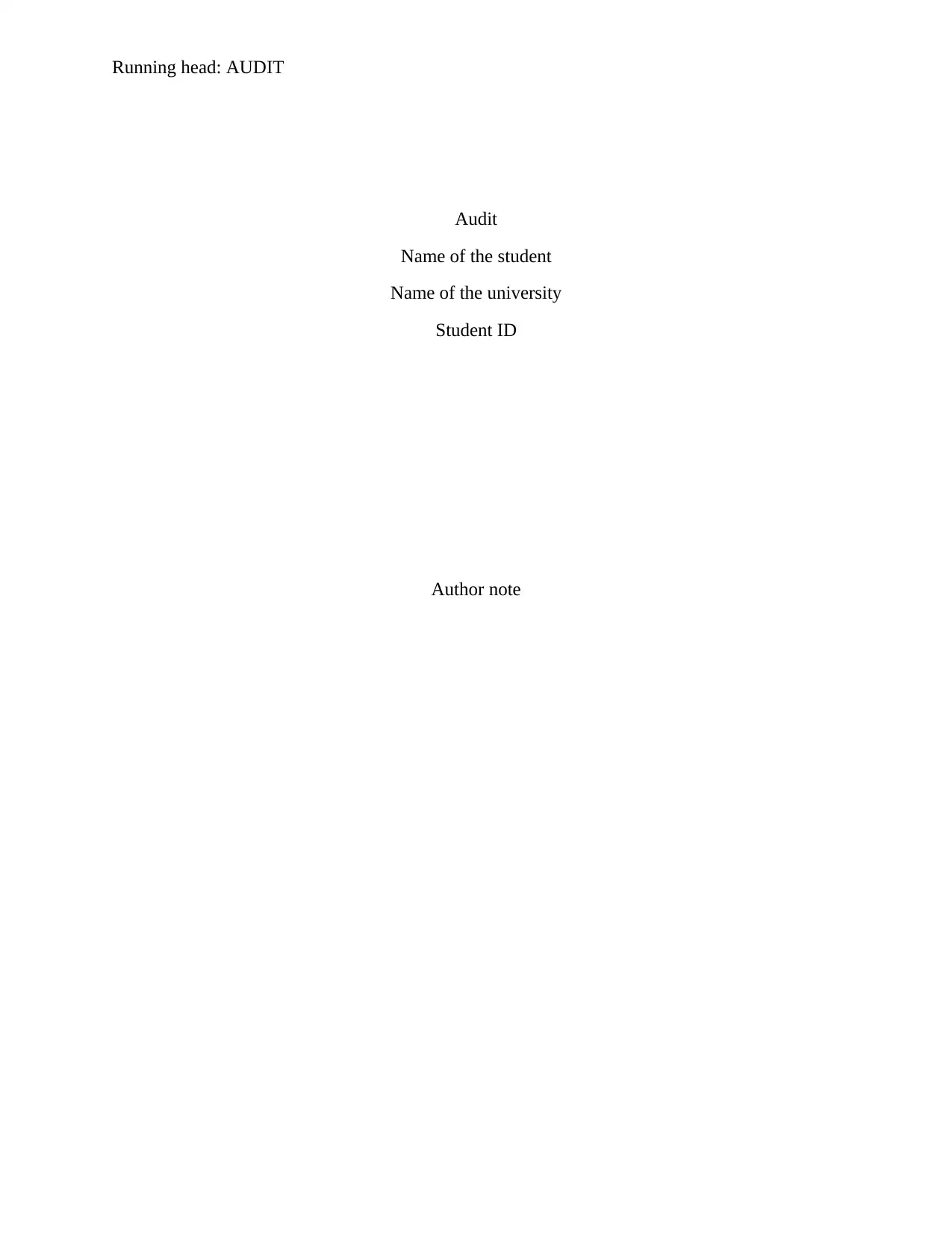
Running head: AUDIT
Audit
Name of the student
Name of the university
Student ID
Author note
Audit
Name of the student
Name of the university
Student ID
Author note
Paraphrase This Document
Need a fresh take? Get an instant paraphrase of this document with our AI Paraphraser
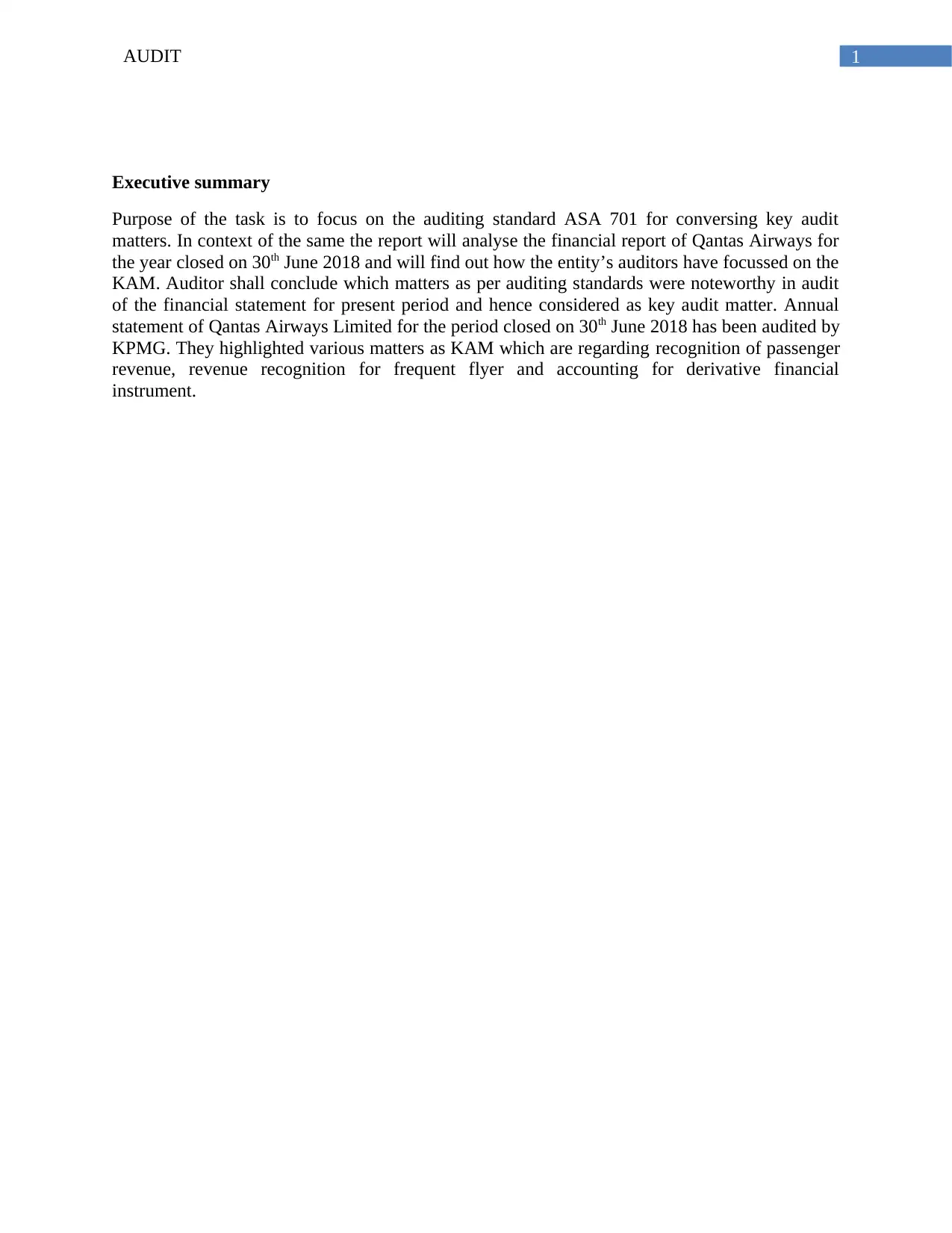
1AUDIT
Executive summary
Purpose of the task is to focus on the auditing standard ASA 701 for conversing key audit
matters. In context of the same the report will analyse the financial report of Qantas Airways for
the year closed on 30th June 2018 and will find out how the entity’s auditors have focussed on the
KAM. Auditor shall conclude which matters as per auditing standards were noteworthy in audit
of the financial statement for present period and hence considered as key audit matter. Annual
statement of Qantas Airways Limited for the period closed on 30th June 2018 has been audited by
KPMG. They highlighted various matters as KAM which are regarding recognition of passenger
revenue, revenue recognition for frequent flyer and accounting for derivative financial
instrument.
Executive summary
Purpose of the task is to focus on the auditing standard ASA 701 for conversing key audit
matters. In context of the same the report will analyse the financial report of Qantas Airways for
the year closed on 30th June 2018 and will find out how the entity’s auditors have focussed on the
KAM. Auditor shall conclude which matters as per auditing standards were noteworthy in audit
of the financial statement for present period and hence considered as key audit matter. Annual
statement of Qantas Airways Limited for the period closed on 30th June 2018 has been audited by
KPMG. They highlighted various matters as KAM which are regarding recognition of passenger
revenue, revenue recognition for frequent flyer and accounting for derivative financial
instrument.
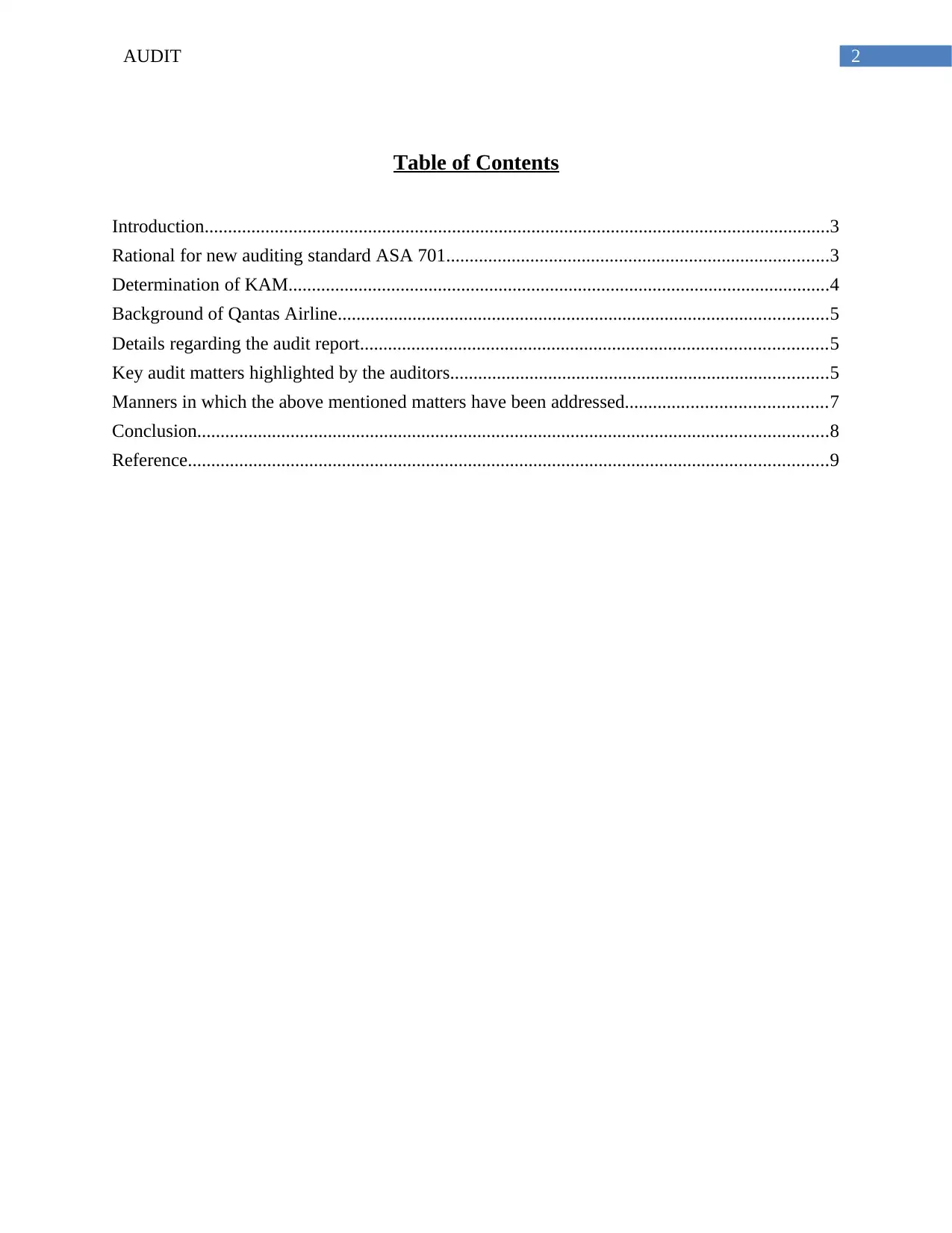
2AUDIT
Table of Contents
Introduction......................................................................................................................................3
Rational for new auditing standard ASA 701..................................................................................3
Determination of KAM....................................................................................................................4
Background of Qantas Airline.........................................................................................................5
Details regarding the audit report....................................................................................................5
Key audit matters highlighted by the auditors.................................................................................5
Manners in which the above mentioned matters have been addressed...........................................7
Conclusion.......................................................................................................................................8
Reference.........................................................................................................................................9
Table of Contents
Introduction......................................................................................................................................3
Rational for new auditing standard ASA 701..................................................................................3
Determination of KAM....................................................................................................................4
Background of Qantas Airline.........................................................................................................5
Details regarding the audit report....................................................................................................5
Key audit matters highlighted by the auditors.................................................................................5
Manners in which the above mentioned matters have been addressed...........................................7
Conclusion.......................................................................................................................................8
Reference.........................................................................................................................................9
⊘ This is a preview!⊘
Do you want full access?
Subscribe today to unlock all pages.

Trusted by 1+ million students worldwide
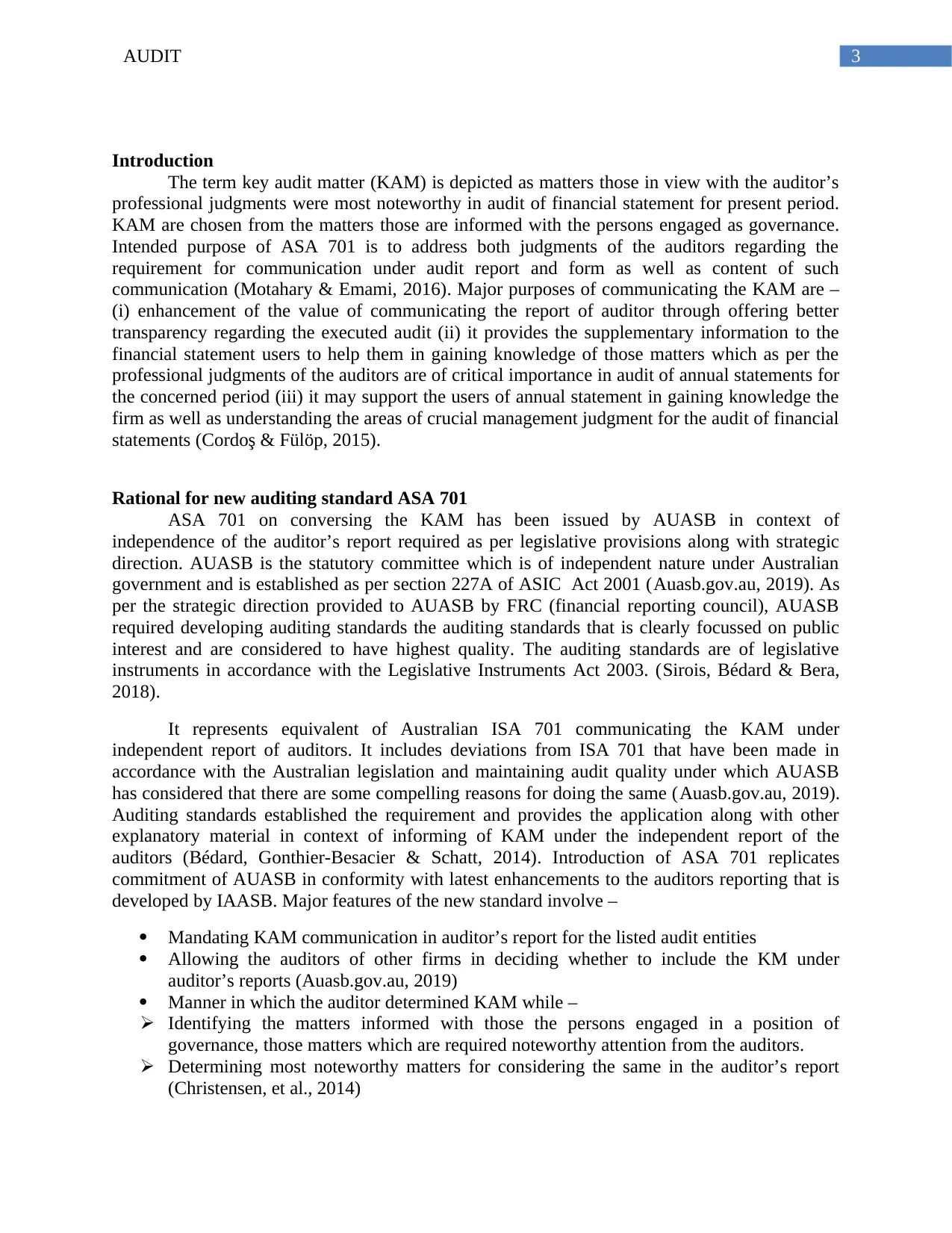
3AUDIT
Introduction
The term key audit matter (KAM) is depicted as matters those in view with the auditor’s
professional judgments were most noteworthy in audit of financial statement for present period.
KAM are chosen from the matters those are informed with the persons engaged as governance.
Intended purpose of ASA 701 is to address both judgments of the auditors regarding the
requirement for communication under audit report and form as well as content of such
communication (Motahary & Emami, 2016). Major purposes of communicating the KAM are –
(i) enhancement of the value of communicating the report of auditor through offering better
transparency regarding the executed audit (ii) it provides the supplementary information to the
financial statement users to help them in gaining knowledge of those matters which as per the
professional judgments of the auditors are of critical importance in audit of annual statements for
the concerned period (iii) it may support the users of annual statement in gaining knowledge the
firm as well as understanding the areas of crucial management judgment for the audit of financial
statements (Cordoş & Fülöp, 2015).
Rational for new auditing standard ASA 701
ASA 701 on conversing the KAM has been issued by AUASB in context of
independence of the auditor’s report required as per legislative provisions along with strategic
direction. AUASB is the statutory committee which is of independent nature under Australian
government and is established as per section 227A of ASIC Act 2001 (Auasb.gov.au, 2019). As
per the strategic direction provided to AUASB by FRC (financial reporting council), AUASB
required developing auditing standards the auditing standards that is clearly focussed on public
interest and are considered to have highest quality. The auditing standards are of legislative
instruments in accordance with the Legislative Instruments Act 2003. (Sirois, Bédard & Bera,
2018).
It represents equivalent of Australian ISA 701 communicating the KAM under
independent report of auditors. It includes deviations from ISA 701 that have been made in
accordance with the Australian legislation and maintaining audit quality under which AUASB
has considered that there are some compelling reasons for doing the same (Auasb.gov.au, 2019).
Auditing standards established the requirement and provides the application along with other
explanatory material in context of informing of KAM under the independent report of the
auditors (Bédard, Gonthier-Besacier & Schatt, 2014). Introduction of ASA 701 replicates
commitment of AUASB in conformity with latest enhancements to the auditors reporting that is
developed by IAASB. Major features of the new standard involve –
Mandating KAM communication in auditor’s report for the listed audit entities
Allowing the auditors of other firms in deciding whether to include the KM under
auditor’s reports (Auasb.gov.au, 2019)
Manner in which the auditor determined KAM while –
Identifying the matters informed with those the persons engaged in a position of
governance, those matters which are required noteworthy attention from the auditors.
Determining most noteworthy matters for considering the same in the auditor’s report
(Christensen, et al., 2014)
Introduction
The term key audit matter (KAM) is depicted as matters those in view with the auditor’s
professional judgments were most noteworthy in audit of financial statement for present period.
KAM are chosen from the matters those are informed with the persons engaged as governance.
Intended purpose of ASA 701 is to address both judgments of the auditors regarding the
requirement for communication under audit report and form as well as content of such
communication (Motahary & Emami, 2016). Major purposes of communicating the KAM are –
(i) enhancement of the value of communicating the report of auditor through offering better
transparency regarding the executed audit (ii) it provides the supplementary information to the
financial statement users to help them in gaining knowledge of those matters which as per the
professional judgments of the auditors are of critical importance in audit of annual statements for
the concerned period (iii) it may support the users of annual statement in gaining knowledge the
firm as well as understanding the areas of crucial management judgment for the audit of financial
statements (Cordoş & Fülöp, 2015).
Rational for new auditing standard ASA 701
ASA 701 on conversing the KAM has been issued by AUASB in context of
independence of the auditor’s report required as per legislative provisions along with strategic
direction. AUASB is the statutory committee which is of independent nature under Australian
government and is established as per section 227A of ASIC Act 2001 (Auasb.gov.au, 2019). As
per the strategic direction provided to AUASB by FRC (financial reporting council), AUASB
required developing auditing standards the auditing standards that is clearly focussed on public
interest and are considered to have highest quality. The auditing standards are of legislative
instruments in accordance with the Legislative Instruments Act 2003. (Sirois, Bédard & Bera,
2018).
It represents equivalent of Australian ISA 701 communicating the KAM under
independent report of auditors. It includes deviations from ISA 701 that have been made in
accordance with the Australian legislation and maintaining audit quality under which AUASB
has considered that there are some compelling reasons for doing the same (Auasb.gov.au, 2019).
Auditing standards established the requirement and provides the application along with other
explanatory material in context of informing of KAM under the independent report of the
auditors (Bédard, Gonthier-Besacier & Schatt, 2014). Introduction of ASA 701 replicates
commitment of AUASB in conformity with latest enhancements to the auditors reporting that is
developed by IAASB. Major features of the new standard involve –
Mandating KAM communication in auditor’s report for the listed audit entities
Allowing the auditors of other firms in deciding whether to include the KM under
auditor’s reports (Auasb.gov.au, 2019)
Manner in which the auditor determined KAM while –
Identifying the matters informed with those the persons engaged in a position of
governance, those matters which are required noteworthy attention from the auditors.
Determining most noteworthy matters for considering the same in the auditor’s report
(Christensen, et al., 2014)
Paraphrase This Document
Need a fresh take? Get an instant paraphrase of this document with our AI Paraphraser
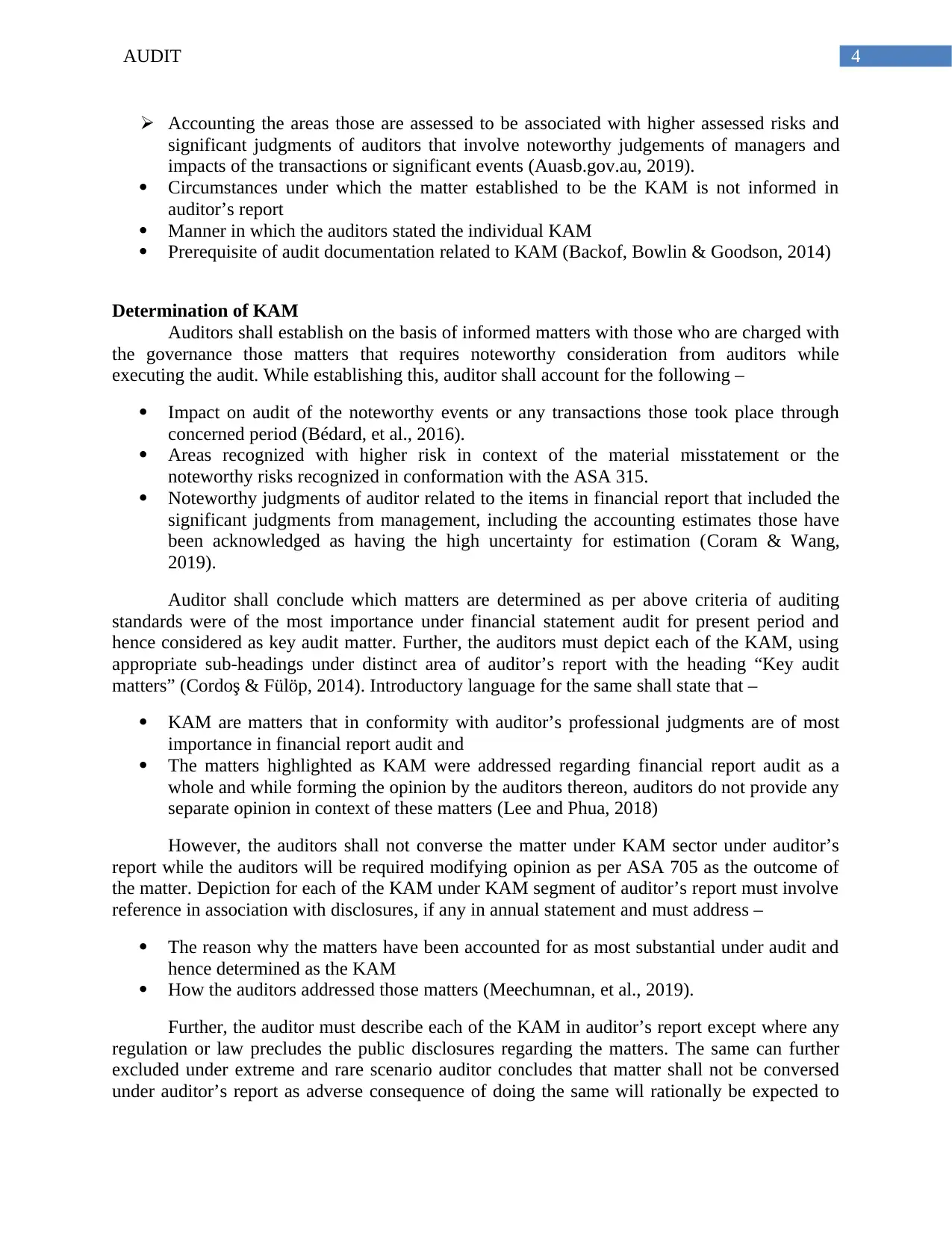
4AUDIT
Accounting the areas those are assessed to be associated with higher assessed risks and
significant judgments of auditors that involve noteworthy judgements of managers and
impacts of the transactions or significant events (Auasb.gov.au, 2019).
Circumstances under which the matter established to be the KAM is not informed in
auditor’s report
Manner in which the auditors stated the individual KAM
Prerequisite of audit documentation related to KAM (Backof, Bowlin & Goodson, 2014)
Determination of KAM
Auditors shall establish on the basis of informed matters with those who are charged with
the governance those matters that requires noteworthy consideration from auditors while
executing the audit. While establishing this, auditor shall account for the following –
Impact on audit of the noteworthy events or any transactions those took place through
concerned period (Bédard, et al., 2016).
Areas recognized with higher risk in context of the material misstatement or the
noteworthy risks recognized in conformation with the ASA 315.
Noteworthy judgments of auditor related to the items in financial report that included the
significant judgments from management, including the accounting estimates those have
been acknowledged as having the high uncertainty for estimation (Coram & Wang,
2019).
Auditor shall conclude which matters are determined as per above criteria of auditing
standards were of the most importance under financial statement audit for present period and
hence considered as key audit matter. Further, the auditors must depict each of the KAM, using
appropriate sub-headings under distinct area of auditor’s report with the heading “Key audit
matters” (Cordoş & Fülöp, 2014). Introductory language for the same shall state that –
KAM are matters that in conformity with auditor’s professional judgments are of most
importance in financial report audit and
The matters highlighted as KAM were addressed regarding financial report audit as a
whole and while forming the opinion by the auditors thereon, auditors do not provide any
separate opinion in context of these matters (Lee and Phua, 2018)
However, the auditors shall not converse the matter under KAM sector under auditor’s
report while the auditors will be required modifying opinion as per ASA 705 as the outcome of
the matter. Depiction for each of the KAM under KAM segment of auditor’s report must involve
reference in association with disclosures, if any in annual statement and must address –
The reason why the matters have been accounted for as most substantial under audit and
hence determined as the KAM
How the auditors addressed those matters (Meechumnan, et al., 2019).
Further, the auditor must describe each of the KAM in auditor’s report except where any
regulation or law precludes the public disclosures regarding the matters. The same can further
excluded under extreme and rare scenario auditor concludes that matter shall not be conversed
under auditor’s report as adverse consequence of doing the same will rationally be expected to
Accounting the areas those are assessed to be associated with higher assessed risks and
significant judgments of auditors that involve noteworthy judgements of managers and
impacts of the transactions or significant events (Auasb.gov.au, 2019).
Circumstances under which the matter established to be the KAM is not informed in
auditor’s report
Manner in which the auditors stated the individual KAM
Prerequisite of audit documentation related to KAM (Backof, Bowlin & Goodson, 2014)
Determination of KAM
Auditors shall establish on the basis of informed matters with those who are charged with
the governance those matters that requires noteworthy consideration from auditors while
executing the audit. While establishing this, auditor shall account for the following –
Impact on audit of the noteworthy events or any transactions those took place through
concerned period (Bédard, et al., 2016).
Areas recognized with higher risk in context of the material misstatement or the
noteworthy risks recognized in conformation with the ASA 315.
Noteworthy judgments of auditor related to the items in financial report that included the
significant judgments from management, including the accounting estimates those have
been acknowledged as having the high uncertainty for estimation (Coram & Wang,
2019).
Auditor shall conclude which matters are determined as per above criteria of auditing
standards were of the most importance under financial statement audit for present period and
hence considered as key audit matter. Further, the auditors must depict each of the KAM, using
appropriate sub-headings under distinct area of auditor’s report with the heading “Key audit
matters” (Cordoş & Fülöp, 2014). Introductory language for the same shall state that –
KAM are matters that in conformity with auditor’s professional judgments are of most
importance in financial report audit and
The matters highlighted as KAM were addressed regarding financial report audit as a
whole and while forming the opinion by the auditors thereon, auditors do not provide any
separate opinion in context of these matters (Lee and Phua, 2018)
However, the auditors shall not converse the matter under KAM sector under auditor’s
report while the auditors will be required modifying opinion as per ASA 705 as the outcome of
the matter. Depiction for each of the KAM under KAM segment of auditor’s report must involve
reference in association with disclosures, if any in annual statement and must address –
The reason why the matters have been accounted for as most substantial under audit and
hence determined as the KAM
How the auditors addressed those matters (Meechumnan, et al., 2019).
Further, the auditor must describe each of the KAM in auditor’s report except where any
regulation or law precludes the public disclosures regarding the matters. The same can further
excluded under extreme and rare scenario auditor concludes that matter shall not be conversed
under auditor’s report as adverse consequence of doing the same will rationally be expected to
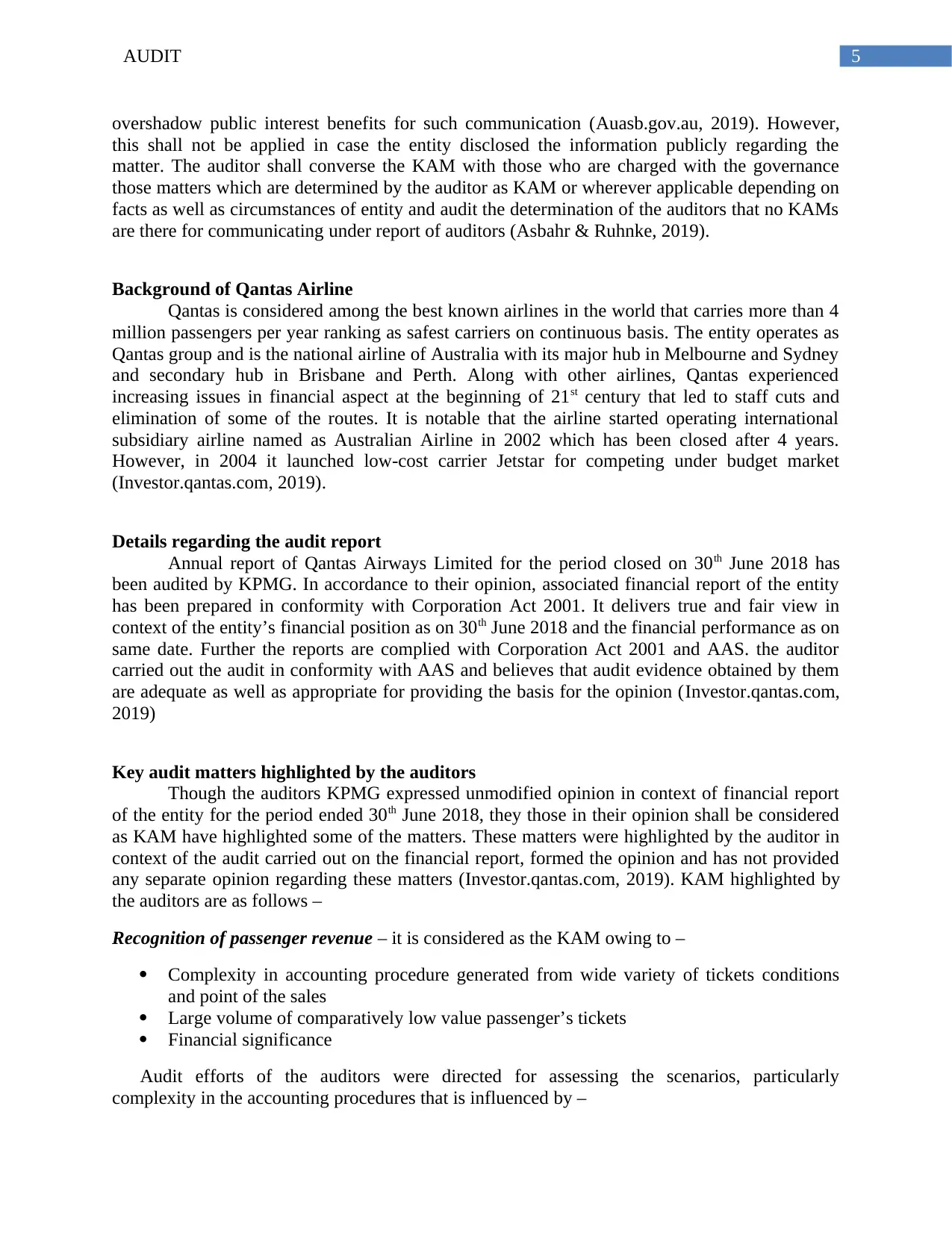
5AUDIT
overshadow public interest benefits for such communication (Auasb.gov.au, 2019). However,
this shall not be applied in case the entity disclosed the information publicly regarding the
matter. The auditor shall converse the KAM with those who are charged with the governance
those matters which are determined by the auditor as KAM or wherever applicable depending on
facts as well as circumstances of entity and audit the determination of the auditors that no KAMs
are there for communicating under report of auditors (Asbahr & Ruhnke, 2019).
Background of Qantas Airline
Qantas is considered among the best known airlines in the world that carries more than 4
million passengers per year ranking as safest carriers on continuous basis. The entity operates as
Qantas group and is the national airline of Australia with its major hub in Melbourne and Sydney
and secondary hub in Brisbane and Perth. Along with other airlines, Qantas experienced
increasing issues in financial aspect at the beginning of 21st century that led to staff cuts and
elimination of some of the routes. It is notable that the airline started operating international
subsidiary airline named as Australian Airline in 2002 which has been closed after 4 years.
However, in 2004 it launched low-cost carrier Jetstar for competing under budget market
(Investor.qantas.com, 2019).
Details regarding the audit report
Annual report of Qantas Airways Limited for the period closed on 30th June 2018 has
been audited by KPMG. In accordance to their opinion, associated financial report of the entity
has been prepared in conformity with Corporation Act 2001. It delivers true and fair view in
context of the entity’s financial position as on 30th June 2018 and the financial performance as on
same date. Further the reports are complied with Corporation Act 2001 and AAS. the auditor
carried out the audit in conformity with AAS and believes that audit evidence obtained by them
are adequate as well as appropriate for providing the basis for the opinion (Investor.qantas.com,
2019)
Key audit matters highlighted by the auditors
Though the auditors KPMG expressed unmodified opinion in context of financial report
of the entity for the period ended 30th June 2018, they those in their opinion shall be considered
as KAM have highlighted some of the matters. These matters were highlighted by the auditor in
context of the audit carried out on the financial report, formed the opinion and has not provided
any separate opinion regarding these matters (Investor.qantas.com, 2019). KAM highlighted by
the auditors are as follows –
Recognition of passenger revenue – it is considered as the KAM owing to –
Complexity in accounting procedure generated from wide variety of tickets conditions
and point of the sales
Large volume of comparatively low value passenger’s tickets
Financial significance
Audit efforts of the auditors were directed for assessing the scenarios, particularly
complexity in the accounting procedures that is influenced by –
overshadow public interest benefits for such communication (Auasb.gov.au, 2019). However,
this shall not be applied in case the entity disclosed the information publicly regarding the
matter. The auditor shall converse the KAM with those who are charged with the governance
those matters which are determined by the auditor as KAM or wherever applicable depending on
facts as well as circumstances of entity and audit the determination of the auditors that no KAMs
are there for communicating under report of auditors (Asbahr & Ruhnke, 2019).
Background of Qantas Airline
Qantas is considered among the best known airlines in the world that carries more than 4
million passengers per year ranking as safest carriers on continuous basis. The entity operates as
Qantas group and is the national airline of Australia with its major hub in Melbourne and Sydney
and secondary hub in Brisbane and Perth. Along with other airlines, Qantas experienced
increasing issues in financial aspect at the beginning of 21st century that led to staff cuts and
elimination of some of the routes. It is notable that the airline started operating international
subsidiary airline named as Australian Airline in 2002 which has been closed after 4 years.
However, in 2004 it launched low-cost carrier Jetstar for competing under budget market
(Investor.qantas.com, 2019).
Details regarding the audit report
Annual report of Qantas Airways Limited for the period closed on 30th June 2018 has
been audited by KPMG. In accordance to their opinion, associated financial report of the entity
has been prepared in conformity with Corporation Act 2001. It delivers true and fair view in
context of the entity’s financial position as on 30th June 2018 and the financial performance as on
same date. Further the reports are complied with Corporation Act 2001 and AAS. the auditor
carried out the audit in conformity with AAS and believes that audit evidence obtained by them
are adequate as well as appropriate for providing the basis for the opinion (Investor.qantas.com,
2019)
Key audit matters highlighted by the auditors
Though the auditors KPMG expressed unmodified opinion in context of financial report
of the entity for the period ended 30th June 2018, they those in their opinion shall be considered
as KAM have highlighted some of the matters. These matters were highlighted by the auditor in
context of the audit carried out on the financial report, formed the opinion and has not provided
any separate opinion regarding these matters (Investor.qantas.com, 2019). KAM highlighted by
the auditors are as follows –
Recognition of passenger revenue – it is considered as the KAM owing to –
Complexity in accounting procedure generated from wide variety of tickets conditions
and point of the sales
Large volume of comparatively low value passenger’s tickets
Financial significance
Audit efforts of the auditors were directed for assessing the scenarios, particularly
complexity in the accounting procedures that is influenced by –
⊘ This is a preview!⊘
Do you want full access?
Subscribe today to unlock all pages.

Trusted by 1+ million students worldwide
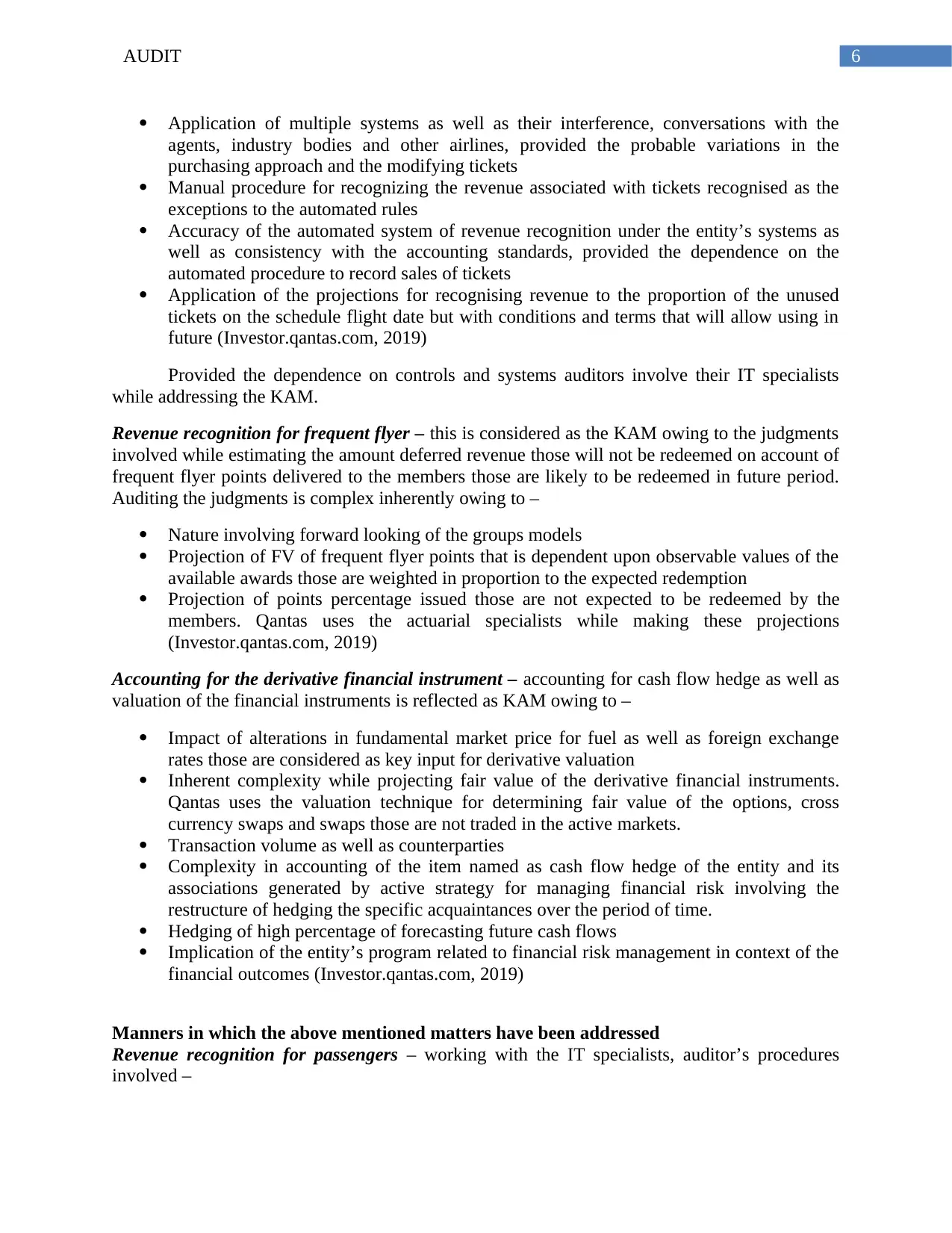
6AUDIT
Application of multiple systems as well as their interference, conversations with the
agents, industry bodies and other airlines, provided the probable variations in the
purchasing approach and the modifying tickets
Manual procedure for recognizing the revenue associated with tickets recognised as the
exceptions to the automated rules
Accuracy of the automated system of revenue recognition under the entity’s systems as
well as consistency with the accounting standards, provided the dependence on the
automated procedure to record sales of tickets
Application of the projections for recognising revenue to the proportion of the unused
tickets on the schedule flight date but with conditions and terms that will allow using in
future (Investor.qantas.com, 2019)
Provided the dependence on controls and systems auditors involve their IT specialists
while addressing the KAM.
Revenue recognition for frequent flyer – this is considered as the KAM owing to the judgments
involved while estimating the amount deferred revenue those will not be redeemed on account of
frequent flyer points delivered to the members those are likely to be redeemed in future period.
Auditing the judgments is complex inherently owing to –
Nature involving forward looking of the groups models
Projection of FV of frequent flyer points that is dependent upon observable values of the
available awards those are weighted in proportion to the expected redemption
Projection of points percentage issued those are not expected to be redeemed by the
members. Qantas uses the actuarial specialists while making these projections
(Investor.qantas.com, 2019)
Accounting for the derivative financial instrument – accounting for cash flow hedge as well as
valuation of the financial instruments is reflected as KAM owing to –
Impact of alterations in fundamental market price for fuel as well as foreign exchange
rates those are considered as key input for derivative valuation
Inherent complexity while projecting fair value of the derivative financial instruments.
Qantas uses the valuation technique for determining fair value of the options, cross
currency swaps and swaps those are not traded in the active markets.
Transaction volume as well as counterparties
Complexity in accounting of the item named as cash flow hedge of the entity and its
associations generated by active strategy for managing financial risk involving the
restructure of hedging the specific acquaintances over the period of time.
Hedging of high percentage of forecasting future cash flows
Implication of the entity’s program related to financial risk management in context of the
financial outcomes (Investor.qantas.com, 2019)
Manners in which the above mentioned matters have been addressed
Revenue recognition for passengers – working with the IT specialists, auditor’s procedures
involved –
Application of multiple systems as well as their interference, conversations with the
agents, industry bodies and other airlines, provided the probable variations in the
purchasing approach and the modifying tickets
Manual procedure for recognizing the revenue associated with tickets recognised as the
exceptions to the automated rules
Accuracy of the automated system of revenue recognition under the entity’s systems as
well as consistency with the accounting standards, provided the dependence on the
automated procedure to record sales of tickets
Application of the projections for recognising revenue to the proportion of the unused
tickets on the schedule flight date but with conditions and terms that will allow using in
future (Investor.qantas.com, 2019)
Provided the dependence on controls and systems auditors involve their IT specialists
while addressing the KAM.
Revenue recognition for frequent flyer – this is considered as the KAM owing to the judgments
involved while estimating the amount deferred revenue those will not be redeemed on account of
frequent flyer points delivered to the members those are likely to be redeemed in future period.
Auditing the judgments is complex inherently owing to –
Nature involving forward looking of the groups models
Projection of FV of frequent flyer points that is dependent upon observable values of the
available awards those are weighted in proportion to the expected redemption
Projection of points percentage issued those are not expected to be redeemed by the
members. Qantas uses the actuarial specialists while making these projections
(Investor.qantas.com, 2019)
Accounting for the derivative financial instrument – accounting for cash flow hedge as well as
valuation of the financial instruments is reflected as KAM owing to –
Impact of alterations in fundamental market price for fuel as well as foreign exchange
rates those are considered as key input for derivative valuation
Inherent complexity while projecting fair value of the derivative financial instruments.
Qantas uses the valuation technique for determining fair value of the options, cross
currency swaps and swaps those are not traded in the active markets.
Transaction volume as well as counterparties
Complexity in accounting of the item named as cash flow hedge of the entity and its
associations generated by active strategy for managing financial risk involving the
restructure of hedging the specific acquaintances over the period of time.
Hedging of high percentage of forecasting future cash flows
Implication of the entity’s program related to financial risk management in context of the
financial outcomes (Investor.qantas.com, 2019)
Manners in which the above mentioned matters have been addressed
Revenue recognition for passengers – working with the IT specialists, auditor’s procedures
involved –
Paraphrase This Document
Need a fresh take? Get an instant paraphrase of this document with our AI Paraphraser
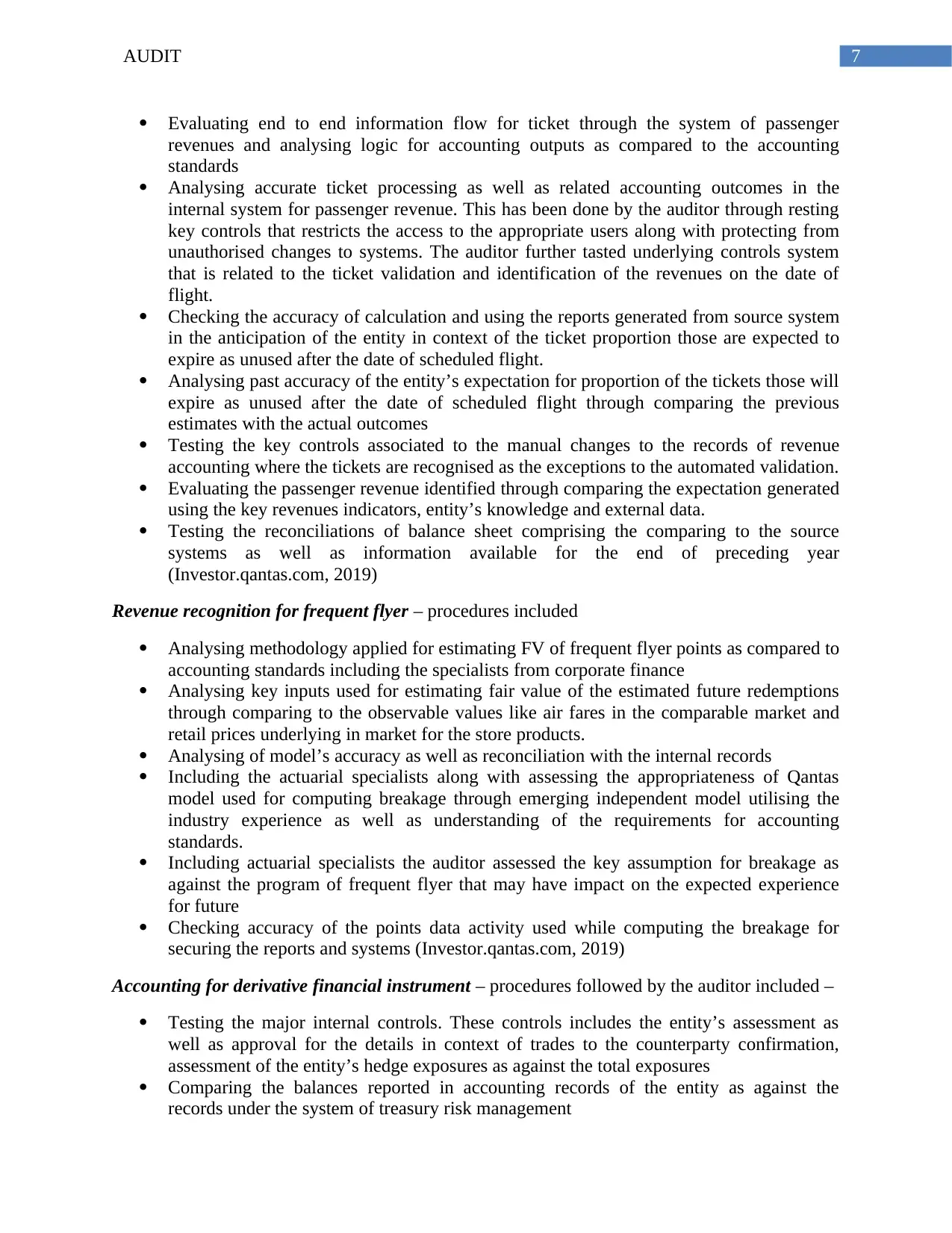
7AUDIT
Evaluating end to end information flow for ticket through the system of passenger
revenues and analysing logic for accounting outputs as compared to the accounting
standards
Analysing accurate ticket processing as well as related accounting outcomes in the
internal system for passenger revenue. This has been done by the auditor through resting
key controls that restricts the access to the appropriate users along with protecting from
unauthorised changes to systems. The auditor further tasted underlying controls system
that is related to the ticket validation and identification of the revenues on the date of
flight.
Checking the accuracy of calculation and using the reports generated from source system
in the anticipation of the entity in context of the ticket proportion those are expected to
expire as unused after the date of scheduled flight.
Analysing past accuracy of the entity’s expectation for proportion of the tickets those will
expire as unused after the date of scheduled flight through comparing the previous
estimates with the actual outcomes
Testing the key controls associated to the manual changes to the records of revenue
accounting where the tickets are recognised as the exceptions to the automated validation.
Evaluating the passenger revenue identified through comparing the expectation generated
using the key revenues indicators, entity’s knowledge and external data.
Testing the reconciliations of balance sheet comprising the comparing to the source
systems as well as information available for the end of preceding year
(Investor.qantas.com, 2019)
Revenue recognition for frequent flyer – procedures included
Analysing methodology applied for estimating FV of frequent flyer points as compared to
accounting standards including the specialists from corporate finance
Analysing key inputs used for estimating fair value of the estimated future redemptions
through comparing to the observable values like air fares in the comparable market and
retail prices underlying in market for the store products.
Analysing of model’s accuracy as well as reconciliation with the internal records
Including the actuarial specialists along with assessing the appropriateness of Qantas
model used for computing breakage through emerging independent model utilising the
industry experience as well as understanding of the requirements for accounting
standards.
Including actuarial specialists the auditor assessed the key assumption for breakage as
against the program of frequent flyer that may have impact on the expected experience
for future
Checking accuracy of the points data activity used while computing the breakage for
securing the reports and systems (Investor.qantas.com, 2019)
Accounting for derivative financial instrument – procedures followed by the auditor included –
Testing the major internal controls. These controls includes the entity’s assessment as
well as approval for the details in context of trades to the counterparty confirmation,
assessment of the entity’s hedge exposures as against the total exposures
Comparing the balances reported in accounting records of the entity as against the
records under the system of treasury risk management
Evaluating end to end information flow for ticket through the system of passenger
revenues and analysing logic for accounting outputs as compared to the accounting
standards
Analysing accurate ticket processing as well as related accounting outcomes in the
internal system for passenger revenue. This has been done by the auditor through resting
key controls that restricts the access to the appropriate users along with protecting from
unauthorised changes to systems. The auditor further tasted underlying controls system
that is related to the ticket validation and identification of the revenues on the date of
flight.
Checking the accuracy of calculation and using the reports generated from source system
in the anticipation of the entity in context of the ticket proportion those are expected to
expire as unused after the date of scheduled flight.
Analysing past accuracy of the entity’s expectation for proportion of the tickets those will
expire as unused after the date of scheduled flight through comparing the previous
estimates with the actual outcomes
Testing the key controls associated to the manual changes to the records of revenue
accounting where the tickets are recognised as the exceptions to the automated validation.
Evaluating the passenger revenue identified through comparing the expectation generated
using the key revenues indicators, entity’s knowledge and external data.
Testing the reconciliations of balance sheet comprising the comparing to the source
systems as well as information available for the end of preceding year
(Investor.qantas.com, 2019)
Revenue recognition for frequent flyer – procedures included
Analysing methodology applied for estimating FV of frequent flyer points as compared to
accounting standards including the specialists from corporate finance
Analysing key inputs used for estimating fair value of the estimated future redemptions
through comparing to the observable values like air fares in the comparable market and
retail prices underlying in market for the store products.
Analysing of model’s accuracy as well as reconciliation with the internal records
Including the actuarial specialists along with assessing the appropriateness of Qantas
model used for computing breakage through emerging independent model utilising the
industry experience as well as understanding of the requirements for accounting
standards.
Including actuarial specialists the auditor assessed the key assumption for breakage as
against the program of frequent flyer that may have impact on the expected experience
for future
Checking accuracy of the points data activity used while computing the breakage for
securing the reports and systems (Investor.qantas.com, 2019)
Accounting for derivative financial instrument – procedures followed by the auditor included –
Testing the major internal controls. These controls includes the entity’s assessment as
well as approval for the details in context of trades to the counterparty confirmation,
assessment of the entity’s hedge exposures as against the total exposures
Comparing the balances reported in accounting records of the entity as against the
records under the system of treasury risk management
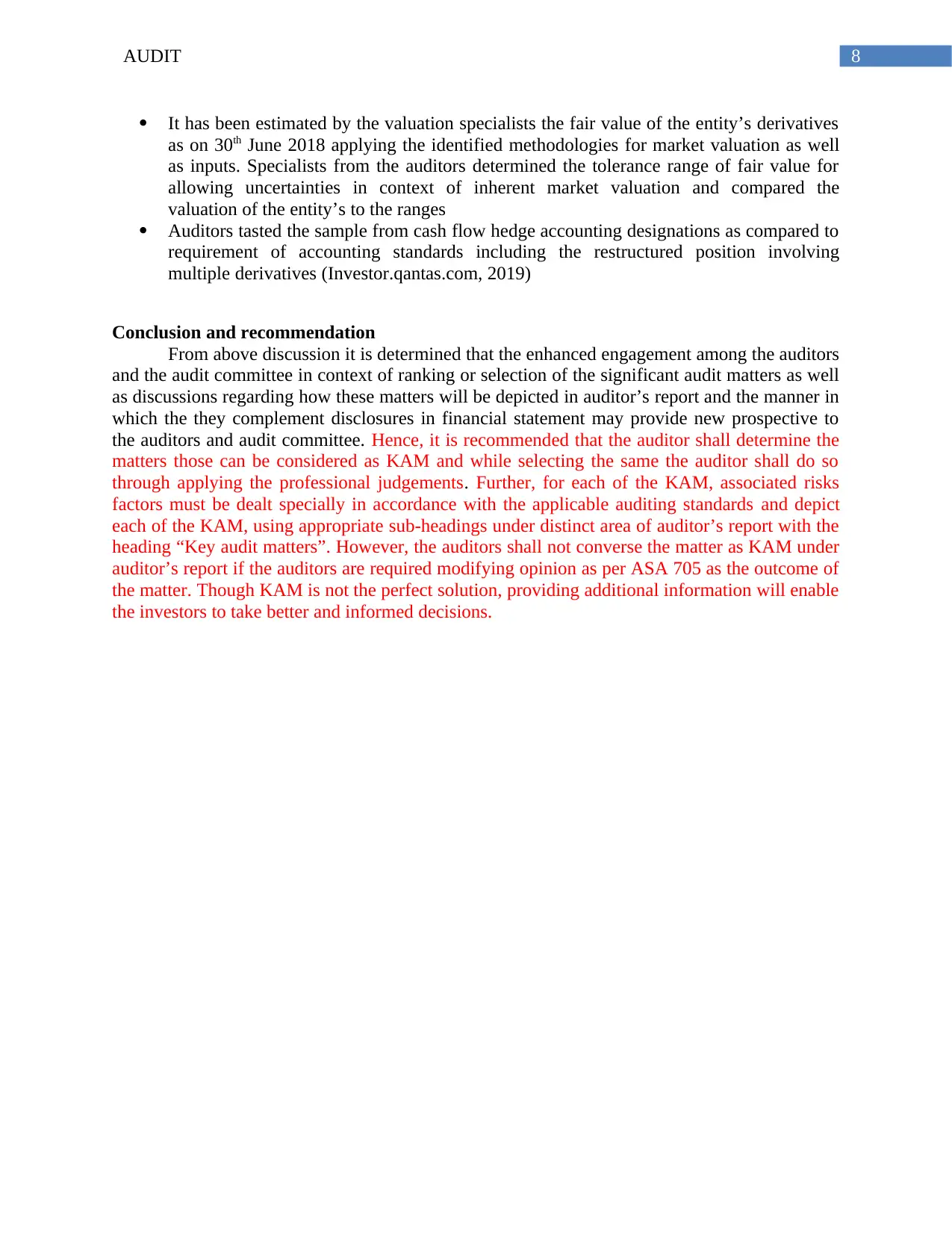
8AUDIT
It has been estimated by the valuation specialists the fair value of the entity’s derivatives
as on 30th June 2018 applying the identified methodologies for market valuation as well
as inputs. Specialists from the auditors determined the tolerance range of fair value for
allowing uncertainties in context of inherent market valuation and compared the
valuation of the entity’s to the ranges
Auditors tasted the sample from cash flow hedge accounting designations as compared to
requirement of accounting standards including the restructured position involving
multiple derivatives (Investor.qantas.com, 2019)
Conclusion and recommendation
From above discussion it is determined that the enhanced engagement among the auditors
and the audit committee in context of ranking or selection of the significant audit matters as well
as discussions regarding how these matters will be depicted in auditor’s report and the manner in
which the they complement disclosures in financial statement may provide new prospective to
the auditors and audit committee. Hence, it is recommended that the auditor shall determine the
matters those can be considered as KAM and while selecting the same the auditor shall do so
through applying the professional judgements. Further, for each of the KAM, associated risks
factors must be dealt specially in accordance with the applicable auditing standards and depict
each of the KAM, using appropriate sub-headings under distinct area of auditor’s report with the
heading “Key audit matters”. However, the auditors shall not converse the matter as KAM under
auditor’s report if the auditors are required modifying opinion as per ASA 705 as the outcome of
the matter. Though KAM is not the perfect solution, providing additional information will enable
the investors to take better and informed decisions.
It has been estimated by the valuation specialists the fair value of the entity’s derivatives
as on 30th June 2018 applying the identified methodologies for market valuation as well
as inputs. Specialists from the auditors determined the tolerance range of fair value for
allowing uncertainties in context of inherent market valuation and compared the
valuation of the entity’s to the ranges
Auditors tasted the sample from cash flow hedge accounting designations as compared to
requirement of accounting standards including the restructured position involving
multiple derivatives (Investor.qantas.com, 2019)
Conclusion and recommendation
From above discussion it is determined that the enhanced engagement among the auditors
and the audit committee in context of ranking or selection of the significant audit matters as well
as discussions regarding how these matters will be depicted in auditor’s report and the manner in
which the they complement disclosures in financial statement may provide new prospective to
the auditors and audit committee. Hence, it is recommended that the auditor shall determine the
matters those can be considered as KAM and while selecting the same the auditor shall do so
through applying the professional judgements. Further, for each of the KAM, associated risks
factors must be dealt specially in accordance with the applicable auditing standards and depict
each of the KAM, using appropriate sub-headings under distinct area of auditor’s report with the
heading “Key audit matters”. However, the auditors shall not converse the matter as KAM under
auditor’s report if the auditors are required modifying opinion as per ASA 705 as the outcome of
the matter. Though KAM is not the perfect solution, providing additional information will enable
the investors to take better and informed decisions.
⊘ This is a preview!⊘
Do you want full access?
Subscribe today to unlock all pages.

Trusted by 1+ million students worldwide
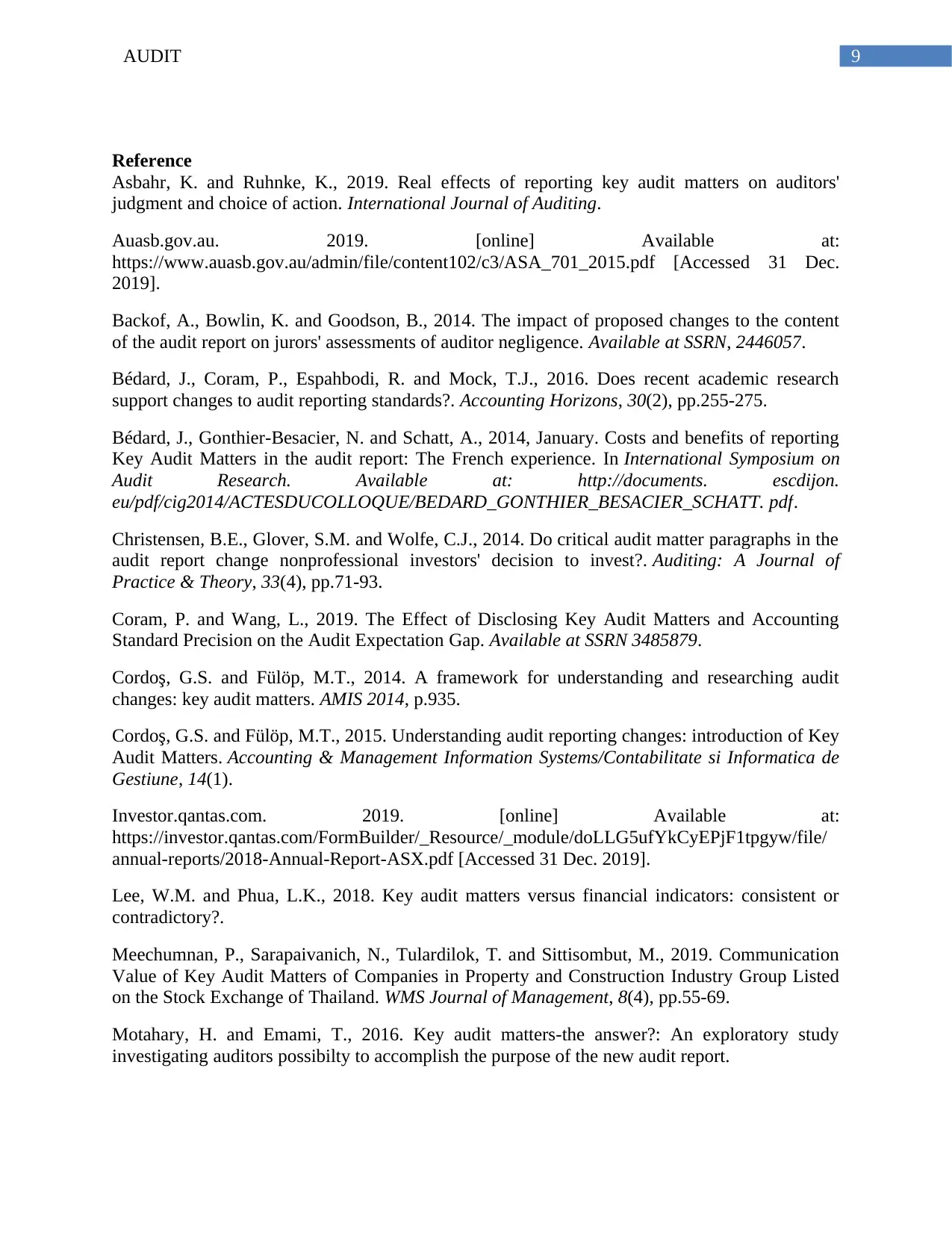
9AUDIT
Reference
Asbahr, K. and Ruhnke, K., 2019. Real effects of reporting key audit matters on auditors'
judgment and choice of action. International Journal of Auditing.
Auasb.gov.au. 2019. [online] Available at:
https://www.auasb.gov.au/admin/file/content102/c3/ASA_701_2015.pdf [Accessed 31 Dec.
2019].
Backof, A., Bowlin, K. and Goodson, B., 2014. The impact of proposed changes to the content
of the audit report on jurors' assessments of auditor negligence. Available at SSRN, 2446057.
Bédard, J., Coram, P., Espahbodi, R. and Mock, T.J., 2016. Does recent academic research
support changes to audit reporting standards?. Accounting Horizons, 30(2), pp.255-275.
Bédard, J., Gonthier-Besacier, N. and Schatt, A., 2014, January. Costs and benefits of reporting
Key Audit Matters in the audit report: The French experience. In International Symposium on
Audit Research. Available at: http://documents. escdijon.
eu/pdf/cig2014/ACTESDUCOLLOQUE/BEDARD_GONTHIER_BESACIER_SCHATT. pdf.
Christensen, B.E., Glover, S.M. and Wolfe, C.J., 2014. Do critical audit matter paragraphs in the
audit report change nonprofessional investors' decision to invest?. Auditing: A Journal of
Practice & Theory, 33(4), pp.71-93.
Coram, P. and Wang, L., 2019. The Effect of Disclosing Key Audit Matters and Accounting
Standard Precision on the Audit Expectation Gap. Available at SSRN 3485879.
Cordoş, G.S. and Fülöp, M.T., 2014. A framework for understanding and researching audit
changes: key audit matters. AMIS 2014, p.935.
Cordoş, G.S. and Fülöp, M.T., 2015. Understanding audit reporting changes: introduction of Key
Audit Matters. Accounting & Management Information Systems/Contabilitate si Informatica de
Gestiune, 14(1).
Investor.qantas.com. 2019. [online] Available at:
https://investor.qantas.com/FormBuilder/_Resource/_module/doLLG5ufYkCyEPjF1tpgyw/file/
annual-reports/2018-Annual-Report-ASX.pdf [Accessed 31 Dec. 2019].
Lee, W.M. and Phua, L.K., 2018. Key audit matters versus financial indicators: consistent or
contradictory?.
Meechumnan, P., Sarapaivanich, N., Tulardilok, T. and Sittisombut, M., 2019. Communication
Value of Key Audit Matters of Companies in Property and Construction Industry Group Listed
on the Stock Exchange of Thailand. WMS Journal of Management, 8(4), pp.55-69.
Motahary, H. and Emami, T., 2016. Key audit matters-the answer?: An exploratory study
investigating auditors possibilty to accomplish the purpose of the new audit report.
Reference
Asbahr, K. and Ruhnke, K., 2019. Real effects of reporting key audit matters on auditors'
judgment and choice of action. International Journal of Auditing.
Auasb.gov.au. 2019. [online] Available at:
https://www.auasb.gov.au/admin/file/content102/c3/ASA_701_2015.pdf [Accessed 31 Dec.
2019].
Backof, A., Bowlin, K. and Goodson, B., 2014. The impact of proposed changes to the content
of the audit report on jurors' assessments of auditor negligence. Available at SSRN, 2446057.
Bédard, J., Coram, P., Espahbodi, R. and Mock, T.J., 2016. Does recent academic research
support changes to audit reporting standards?. Accounting Horizons, 30(2), pp.255-275.
Bédard, J., Gonthier-Besacier, N. and Schatt, A., 2014, January. Costs and benefits of reporting
Key Audit Matters in the audit report: The French experience. In International Symposium on
Audit Research. Available at: http://documents. escdijon.
eu/pdf/cig2014/ACTESDUCOLLOQUE/BEDARD_GONTHIER_BESACIER_SCHATT. pdf.
Christensen, B.E., Glover, S.M. and Wolfe, C.J., 2014. Do critical audit matter paragraphs in the
audit report change nonprofessional investors' decision to invest?. Auditing: A Journal of
Practice & Theory, 33(4), pp.71-93.
Coram, P. and Wang, L., 2019. The Effect of Disclosing Key Audit Matters and Accounting
Standard Precision on the Audit Expectation Gap. Available at SSRN 3485879.
Cordoş, G.S. and Fülöp, M.T., 2014. A framework for understanding and researching audit
changes: key audit matters. AMIS 2014, p.935.
Cordoş, G.S. and Fülöp, M.T., 2015. Understanding audit reporting changes: introduction of Key
Audit Matters. Accounting & Management Information Systems/Contabilitate si Informatica de
Gestiune, 14(1).
Investor.qantas.com. 2019. [online] Available at:
https://investor.qantas.com/FormBuilder/_Resource/_module/doLLG5ufYkCyEPjF1tpgyw/file/
annual-reports/2018-Annual-Report-ASX.pdf [Accessed 31 Dec. 2019].
Lee, W.M. and Phua, L.K., 2018. Key audit matters versus financial indicators: consistent or
contradictory?.
Meechumnan, P., Sarapaivanich, N., Tulardilok, T. and Sittisombut, M., 2019. Communication
Value of Key Audit Matters of Companies in Property and Construction Industry Group Listed
on the Stock Exchange of Thailand. WMS Journal of Management, 8(4), pp.55-69.
Motahary, H. and Emami, T., 2016. Key audit matters-the answer?: An exploratory study
investigating auditors possibilty to accomplish the purpose of the new audit report.
Paraphrase This Document
Need a fresh take? Get an instant paraphrase of this document with our AI Paraphraser
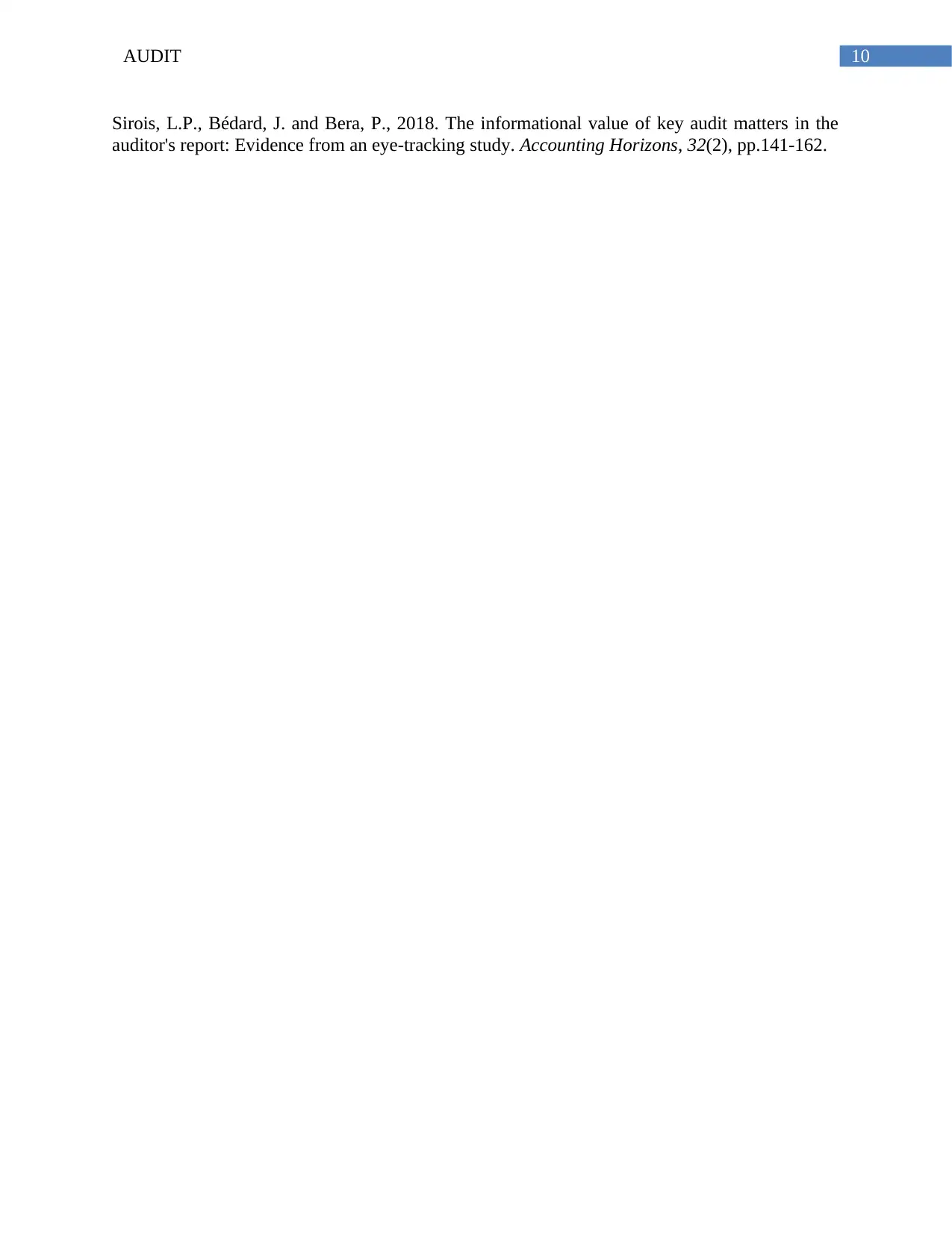
10AUDIT
Sirois, L.P., Bédard, J. and Bera, P., 2018. The informational value of key audit matters in the
auditor's report: Evidence from an eye-tracking study. Accounting Horizons, 32(2), pp.141-162.
Sirois, L.P., Bédard, J. and Bera, P., 2018. The informational value of key audit matters in the
auditor's report: Evidence from an eye-tracking study. Accounting Horizons, 32(2), pp.141-162.
1 out of 11
Related Documents
Your All-in-One AI-Powered Toolkit for Academic Success.
+13062052269
info@desklib.com
Available 24*7 on WhatsApp / Email
![[object Object]](/_next/static/media/star-bottom.7253800d.svg)
Unlock your academic potential
Copyright © 2020–2025 A2Z Services. All Rights Reserved. Developed and managed by ZUCOL.





